theartsdesk Q&A: Stage Designer Es Devlin | reviews, news & interviews
theartsdesk Q&A: Stage Designer Es Devlin
theartsdesk Q&A: Stage Designer Es Devlin
After a hiatus of five years, the stage designer has a new play at the Arcola
For the past five years British stage designer Es Devlin has been creating extraordinarily ambitious and imaginative sets for some of the biggest crowd-pullers in the music industry, from Take That to Lady Gaga. But this week she returns to her theatrical roots with a new play, Pieces of Vincent, by David Watson at the small but prestigious Arcola Theatre in London.
Devlin, who is 38, was brought up in Kent and is the second of four children. Her first professional job, on the strength of winning the Linbury Prize for Stage Design, was Edward II at the Bolton Octagon after which her career trajectory rose with almost indecent haste. Her work includes theatre productions for the RSC, National Theatre, Royal Court, Almeida, West End and Broadway – as well as operas for the Royal Opera House, ENO, Glyndebourne, Netherlands Opera and Barcelona’s Liceu.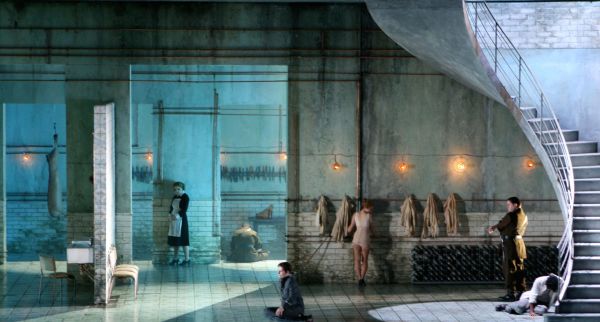 Not surprisingly, the first thing that strikes me when I meet Devlin at her studio, based in the home that she shares with her husband, the costume designer Jack Galloway, and her two young children is that she’s a grafter, and not simply because of the number and diversity of projects under her belt but her total commitment to whatever she is working on at any given time. She was invited to design Mika’s 1998 show in Paris after the musician saw an edition of the South Bank Show which featured Devlin working alongside David McVicar on a production of Salome for the Royal Opera House (pictured above, right).
Not surprisingly, the first thing that strikes me when I meet Devlin at her studio, based in the home that she shares with her husband, the costume designer Jack Galloway, and her two young children is that she’s a grafter, and not simply because of the number and diversity of projects under her belt but her total commitment to whatever she is working on at any given time. She was invited to design Mika’s 1998 show in Paris after the musician saw an edition of the South Bank Show which featured Devlin working alongside David McVicar on a production of Salome for the Royal Opera House (pictured above, right).
“He saw how I worked and worked at it, how the show went through all these different incarnations and I think he thought, ‘God, that’s what I want – someone who’s just going to thrash away until it’s what I want,’” says Devlin.
Hilary Whitney: Pieces of Vincent is your first set design for a play since Macbeth in 2005 – also at the Arcola Theatre. Was it a conscious decision to take such a lengthy break from the theatre?
ES DEVLIN: Not really, it’s more about hours in the day. I’ve been offered some stuff I’d loved to have done, collaborating with Daniel Kramer and David Leveaux and Max [Stafford-Clark] but I just didn’t have the time. Theatre, opera and pop work on very different timescales: operas are normally booked two to four years in advance, pop shows can be anything from a few days to a year’s notice – so, oddly, these seem to mesh quite well. Theatre schedules tend to come at shorter notice than opera but still require the dedicated period of exclusive commitment, so it can be hard to make it all jigsaw together – not to mention the schedule that having a three-year-old and a six-month-old imposes on life in general!.
Then Clare Lizzimore, the director of Pieces of Vincent, approached me and she just didn’t give up. She kept phoning my agent to ask if I’d read the play so I decided that I ought to meet her and find out exactly why she was so keen for me to do this play. So we met and very quickly came up with an idea and I thought, “Hmm…this could be really good.” I’d just had my second baby and I thought, “Well, I’m here, I don’t want to leave London at the moment because of the baby, so maybe this could work.”
In fact, the idea we had then, is not the idea we went with but it was important because I didn't know Clare's work then and I wanted to make sure that her intention was to be theatrically bold. I needed to know she was going to take this play and experiment with the form a bit. The play lends itself to that really, it's a bit like Pinter's Betrayal or Altmans Short Cuts. You get a fragment of everybody's lives and then you realise how they all fit together.
Your route to stage design wasn't straightforward.
No, I came to it quite late really. Actually, it’s funny because when I was working with the Haus of Gaga [Lady Gaga's creative team] they asked me how long I’d been a set designer. and when I told them I’d been doing it for 15 years they said, “So what did you do before?” Because of course, 15 years ago, I was 23 and they’re all 23 now and at the peak of their careers, whereas I didn’t get my first design job until I was 25.
When I was at school I was so interested in so many things I found it hard to make choices. My original plan was to study Mandarin and I was also obsessed with music. I learnt the violin, the clarinet and the piano and I spent hours and hours practising them rigorously. It was generally thought that I might be good at music so my parents and my granddad, none of whom were well off – I’m one of four kids – scraped the money together to send me to the Junior Exhibitioners' course which was every Saturday morning at the Royal Academy of Music. So every week I would get the train up to London and meet these extraordinary people - real musical geniuses, which I certainly wasn’t. But it gave me a real buzz, just being in the same environment as those people and I remember walking down the corridors catching snippets of people practising and being extremely conscious that I was somewhere very special. I definitely wasn’t as good as most of the other pupils but I did work very hard, but I just couldn’t keep it up once I started my A-levels.
And of course, I was very interested in art. I loved painting and I was always a bit of a magpie, attracted to things that glow - I could often be found in a corner, with bits of cellophane and light bulbs. There was a tradition in our family that if you wanted to give someone a present, you had to make them something and we all did that right through school.
However, I had quite a charismatic English teacher which is probably why I ended up studying English at Bristol University. But in that way my life then was very similar to my life now in that there were so many exciting things to do and not enough hours in the day to do them.
You didn’t consider going to art college at that point?
Not straight after school, no. You see in those days, if you wanted to study art, first of all you had to go to a local art college and do a foundation course and I’d reached the point where I was more than ready to leave home, so that didn’t appeal at all. I also think I felt I wasn’t ready for art college. I had an instinct, even then, that I would need to have lived a bit and done a few things before just being left in a room with a paintbrush. I didn’t think I had enough to say. I didn’t have the audacity, I think, to express what an 18-year-old has to express – I still needed a structure and I wanted to learn more.
So I went to Bristol, which was brilliant and again, I worked really hard. I don’t think I really needed to but it was just habit by then. I spent a lot of hours in the library reading everything I could and writing massive dissertations which were very focussed on the visual aspects of language. My final dissertation was about map-making in the poetry of Adrienne Rich – I always came back to the concrete.
Bristol has a very strong tradition of drama - were you ever tempted to act or direct?
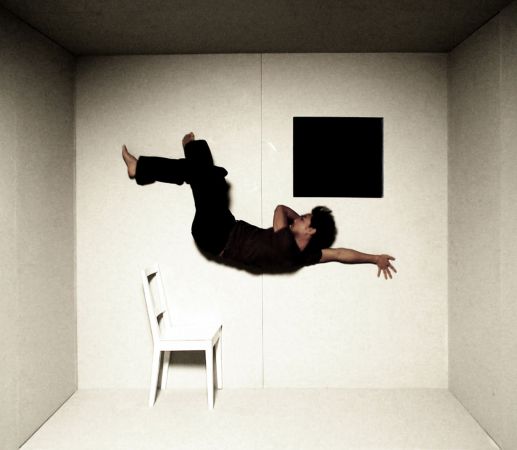 I got a bit involved in drama there. I co-directed and designed Diary of a Somebody, a piece about Joe Orton and the music shows I work on involve quite a bit of directing. I was the creative director for the last two Pet Shop Boys tours and I directed a video for Imogen Heap. But the piece of direction I'm proudest of is a piece I did with Nitin Sawhney and a brilliant animator called Luke Halls - I directed a film that was an hour and 10 long to accompany a show at the IMAX (above, left). I can definitely see myself doing some more directing in the future but now is not the time - two little kids, lots of funky pop stars, lots of interesting new worlds to enter into. But I'm looking forward to when the time is right.
I got a bit involved in drama there. I co-directed and designed Diary of a Somebody, a piece about Joe Orton and the music shows I work on involve quite a bit of directing. I was the creative director for the last two Pet Shop Boys tours and I directed a video for Imogen Heap. But the piece of direction I'm proudest of is a piece I did with Nitin Sawhney and a brilliant animator called Luke Halls - I directed a film that was an hour and 10 long to accompany a show at the IMAX (above, left). I can definitely see myself doing some more directing in the future but now is not the time - two little kids, lots of funky pop stars, lots of interesting new worlds to enter into. But I'm looking forward to when the time is right.
It was when I finished my degree that I decided I was ready for art college and I enrolled on a foundation course at St Martins - my family just threw their hands up and said, “Well, that’s you in education for another five years.”
I loved it. Everyone else was much younger than me but I felt I was just the right age to do it and I took it very seriously. We would spend one week sculpting or doing photography or print-making and we did life-drawing every day. It was a fantastic year and I’d love to feed a bit of that energy into life right now. The occasional morning of life-drawing or print-making – wonderful.
But I had to decide what do next. I knew I wanted a career in art so I thought I might train as a graphic designer – it was the Eighties and it was the only way I could realistically envisage earning any money – but one of the tutors in St Martins said to me, “Es, you could do that but how do you know you’ll be a good graphic designer? You might not even get a job. Why don’t you do what you like doing and if you do it long enough, you’ll get good at it and if you get good at it, someone will pay you to do it?” And I think that’s really good advice – at least it’s worked for me. OK, there’s a certain amount of luck involved but if you keep at it, you will become your own kind of specialist.
So that’s when you decided you’d like to be a set designer?
Well, it wasn’t immediately obvious, at least not to me. We spent a week doing theatre design and it didn’t appeal, oddly enough, and I was thinking about spending another three or four years at St Martins studying photography and print-making, which I know I would have loved. But about three different tutors told me I should visit the Motley [Theatre Design Course], so I did. It’s round the back of the Theatre Royal, Drury Lane and it’s a bit – they wouldn’t mind me saying this – hovel-like, but I just walked in and I could just smell I was with my own kind. It was like, “OK, so this is it. It would be silly to resist. This is obviously where I’m meant to be.”
It’s a very intense course.You have to complete six projects in a year. A director will come in and give you a brief you on a production and then you work very closely alongside an established designer who mentors you. Then you deliver the design and give a presentation to another set designer, who gives you feedback – and they’re not sweet about it. They can really lay into you, you have to be pretty robust.
You obviously did OK because you won the highly prestigious Linbury Prize for Stage Design.
Yes. The Linbury happens every two years. You submit your portfolio and if you’re selected you go through a further process where you work with a director on a theoretical production, which if you win, will be produced, so it’s an amazing career opportunity.
I designed a production of Edward II for Lawrence Till at the Bolton Octagon, which is a wonderful space. I converted it into a swimming pool – I found a really good derelict pool in Gloucester Road I think it was, and took some photos to show Lawrence. He told me to go for it, so I tiled the Octagon and put in showers.
Sorry, I don’t get the connection between Edward II and swimming pools.
It was 1996, very much the time of Reservoir Dogs, and I wanted a really effective backdrop for all the torture – you know, somewhere that would really show off all the splurges of blood to their best advantage.
And then you went to become Associate Artist at the Bush where your fifth play for that theatre, Mark O’Rowe’s Howard the Rookie was awarded best TMA Design,1998.
That was great. Bradwell [Mike Bradwell, then the Artistic Director of the Bush] took a real leap of faith with me because he’d become known for doing really naturalistic environments and a lot of my work at the time was a reaction against what I saw going on around me, which was a very literal naturalism. Now we have a much more super-naturalism going on, more germane, more enlightened but at the time, I wasn’t interested in, you know, doors and windows. Howard the Rookie is a bit like a road movie and it consists of just two rather beautiful monologues, like a poem, and having visited the place where it is set, which is just outside Dublin, what really stood out for me was the vivid green grass, the stained concrete and the barbed wire. So we put a strip of white on the floor for the road and then cooked it right down so that the set just consisted of concrete, moss and barbed wire. The idea was that the language would take you where you needed to be in terms of the detail.
It’s already becoming very clear how important research is to you. For example, you even went to a bullfight with Sally Potter to research the production of Carmen she directed - and you designed - for English National Opera in 2007.
The thing about research is that any meeting I have, whether it’s with a theatre director or a musical artist, it’s all about generating ideas and research is the fuel that stokes the whole process. Sitting on the bus, going to an exhibition, watching TV with my children, whatever it is, it all comes out somewhere. Some of it comes from a long time ago, from travelling I did in my twenties or books I read when I was at university – thank God I crammed so much into all that time or otherwise I wouldn’t be able to keep all the ideas coming.
But to go back to the Bush, the first play I designed there, Love and Understanding by Joe Penhall, which was also directed by Mike, was also very important. I just waltzed in and said, “Let’s turn this into an x-ray box,” and then had the audacity to write to Trevor Nunn saying, “Please can you come and watch my show?” And not only did he come and watch the show, he also offered me a job at the Lyttelton designing Harold Pinter’s Betrayal.
Which was a very ambitious project.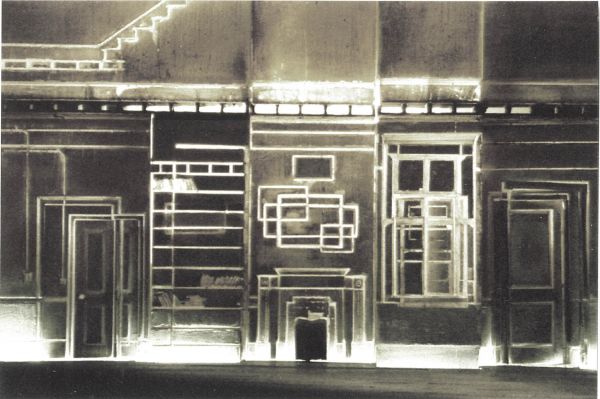 At the time I was still really involved in the world of fine art and was very influenced by artists such as Cornelia Parker and Rachel Whiteread – I still am. I’d seen Rachel Whiteread’s House and I said to Trevor, “I see this as a play about remembered rooms – wouldn’t it be great if we could just pitch up outside House and do it there?” And Trevor agreed, but of course we couldn’t do that so I suggested that we should recreate something along the lines of House but make it not just about one building but about all the places the characters in Betrayal remember, such as the bar and the room in Venice. (Betrayal, pictured above right)
At the time I was still really involved in the world of fine art and was very influenced by artists such as Cornelia Parker and Rachel Whiteread – I still am. I’d seen Rachel Whiteread’s House and I said to Trevor, “I see this as a play about remembered rooms – wouldn’t it be great if we could just pitch up outside House and do it there?” And Trevor agreed, but of course we couldn’t do that so I suggested that we should recreate something along the lines of House but make it not just about one building but about all the places the characters in Betrayal remember, such as the bar and the room in Venice. (Betrayal, pictured above right)
I’d made elevations of each of the spaces referred to in the play and put them on top of each other in a sort of mish-mash as a present for Trevor and Imogen [Stubbs, Nunn’s wife] – you see, I was still making presents even then. So I made a carving of that in the style of a Rachel Whiteread impression and wrote to her and said, “Look, ideally we’d like to do the play in your House but we can’t, we have to do it on stage. Here’s my design, what do you think?” And she said, “Off you go, do it.”
The furniture was attached to three conveyor belts which went in different directions so that the furniture could glide off and click into different positions. We also made some films because one thing Trevor and I both thought, and Harold Pinter was really into this, was that there was a subtext that was all about the barely mentioned children - Trevor and Imogen’s children were very small at the time so I think this was something that resonated with Trevor quite strongly. So we made these films with Trevor’s children, and some other children, and in each of the scene changes we played films of these innocent little kids running about and at the same time the furniture would be constantly moving around, reconfiguring to evoke different memories. But of course, the play works very well without any of that! It was just something I felt I had to do at the time.
In the same year, 1998, you also designed Four Scenes, choreographed by Christopher Bruce for Rambert Dance Company. Not only was it your first dance piece, it was the inaugural production at the newly rebuilt Sadler’s Wells.
I thought I’d died and gone to heaven. I’d only been working for two years and already I was working at the Lyttelton and Sadler’s Wells. And at the same time, David Leveaux had set me up with a project he was working on with a theatre company in Japan [Piano, directed by Harumi Nakajima] so I was flying business class to Tokyo.
Not bad for someone who was worried how she was going to make a living from art.
Well, I probably wasn’t making much of a living at the time but I definitely felt that things were happening. It was an exciting time.
Designing for the stage is, obviously, extremely collaborative. Is it sometimes a battle of wills?
It can be. I think that Sacha Wares would freely admit, as I would, that we created some really interesting work together, such as Perapalas at the Gate, but it wasn’t always straightforward. However, when you’re working with someone as brilliant as Sacha, who really has an eye for detail, as long as the path is open both ways and I can sit in rehearsal and say, “But what if you slant the scene a bit more in this direction?” it can work very well.
Direction and design is a pretty symbiotic process. Macbeth [directed by Max Stafford-Clark at the Arcola 2005] was a really successful collaboration. It was Max’s idea to do it promenade but I think I pushed him further than he originally intended to take it.
I’ve also been working with opera director Keith Warner for seven years now and we have the sort of relationship where we recognise that when the other one has a really strong idea, we just have to go with. For instance, with Faust, he’d been on my balcony and seen a shaving mirror and a zoetrope knocking around and said, “I’ve got it, let’s do mirrors.” And it worked really well. Then another time, he’d been having some ideas for Don Giovanni when Jack and I suddenly came up with the idea that it had to be set in a hotel. We tracked Keith down and told him what we wanted to do and although it was quite late in schedule in opera terms, Keith told us to go ahead.
But obviously, the quality of collaboration is as different as the quality of the conversation and relationship you have with anyone at any level. No two will ever be the same. And some directors are more available than others.
Tell me more about your design for Keith Warner's production of Macbeth with Keith Warner for the Theater an der Wien in Vienna.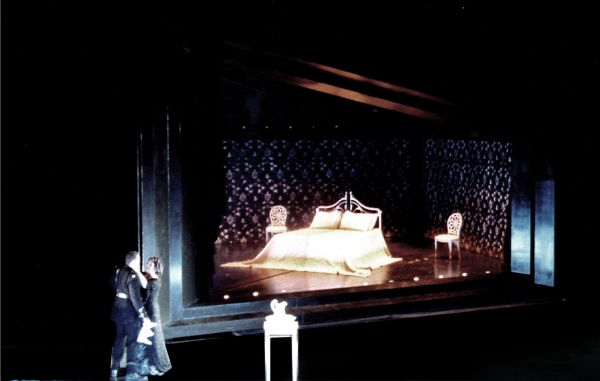 I’d done opera projects with youth groups before but this was my first big international opera and again, it was very generous of Keith to take a punt on me. We cooked up this illusion box with a sliced diagonal mirror which revolved and as it turned, you could see half of the dining table with the meal all going swimmingly and the other half showed what was really going on in Macbeth’s mind – a blood-covered Banquo. It was a version of Pepper’s Ghost, a trick used by Victorian magicians to create ghosts. The audience really didn’t understand how it worked because you couldn’t see it was a mirror for most of the time. For instance, you saw a bed, (pictured above, left) but actually it was only half a bed because the other side was a reflection and then the mirror opened up and you saw all 60 members of the chorus reflected ad infinitum.
I’d done opera projects with youth groups before but this was my first big international opera and again, it was very generous of Keith to take a punt on me. We cooked up this illusion box with a sliced diagonal mirror which revolved and as it turned, you could see half of the dining table with the meal all going swimmingly and the other half showed what was really going on in Macbeth’s mind – a blood-covered Banquo. It was a version of Pepper’s Ghost, a trick used by Victorian magicians to create ghosts. The audience really didn’t understand how it worked because you couldn’t see it was a mirror for most of the time. For instance, you saw a bed, (pictured above, left) but actually it was only half a bed because the other side was a reflection and then the mirror opened up and you saw all 60 members of the chorus reflected ad infinitum.
When you’re coming up with ideas, do you every worry how they are going to materialize or do you just think, “Oh, someone will sort that out?”
I had this conversation only yesterday with Malcolm Birkett who is a fantastic technical collaborator who tries to make my ideas happen, and he told me that one of the things he had learnt from another designer he works with is to never present anything to anyone unless you know that the technology is available to make it happen. And I entirely disagree with that, because then you’d only be working with existing technology. For the big pop shows for example, I hand over my ideas to the best engineers on the planet – which at the moment seems to be an American company called Tait Towers – and push them to come up with the very best they can, which might mean developing something entirely new piece of technology.
And so far that’s worked out OK.
Yes, but there’s a lot of by-product in this studio. For every project there are a lot of more fantastical versions that didn’t happen.
As you said, the big shows are very technically demanding. How did you start designing music events?
The first one was Flag:Burning, a farewell gig at the Barbican for Wire, a very influential punk band. I’d been to quite a few gigs and I’d always been frustrated by the way bands are always presented – a big sort of lump with a jumble of instruments and wires and the drummer at the back. But I’d been to a couple of U2 gigs, designed by Willie Williams, who I’d say is the godfather of visionary rock n’ roll shows, although I didn’t know his name at the time, so I knew there were other possibilities.'
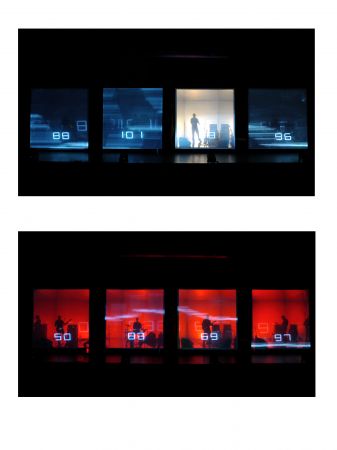 Of course now I realise there’s a reason why bands always look like that – it’s so they can see each other and they can play. It’s really obvious when you think about it but luckily I didn’t know that at the time so I just went ahead with my own idea which was to put each member of Wire into box with a projection screen at the back and gauze on the front (pictured right). Then I went to a hospital and borrowed an ECG machine which they were all connected to so that their heartbeats were recorded on the front of each member's particular box. I also wanted to do the same with MRI scans reading their brains but I couldn’t quite pull that off, although it would probably be possible today. We also filmed the band as they were playing and then projected bits of their eyes, nose and mouth, so you got a sense of composite band creature.
Of course now I realise there’s a reason why bands always look like that – it’s so they can see each other and they can play. It’s really obvious when you think about it but luckily I didn’t know that at the time so I just went ahead with my own idea which was to put each member of Wire into box with a projection screen at the back and gauze on the front (pictured right). Then I went to a hospital and borrowed an ECG machine which they were all connected to so that their heartbeats were recorded on the front of each member's particular box. I also wanted to do the same with MRI scans reading their brains but I couldn’t quite pull that off, although it would probably be possible today. We also filmed the band as they were playing and then projected bits of their eyes, nose and mouth, so you got a sense of composite band creature.
And how did they feel about not being able to see each other?
Well, they did their best although I think what really threw them was that because I didn’t have enough budget for any Velcro, I’d had to staple them into their boxes and they couldn’t get out. I think the audience, who were quite a bolshy lot, were quite surprised they didn’t come out to take a bow for their final concert but I think because it was Wire, they just came to accept it as part of the act. What they didn’t realise was that long after they’d gone, the band were still cooped up in the boxes. You know that film, Spinal Tap? I’ve never seen it and I refuse to see it because everyday of my life, someone tells me that what I’m doing is pure Spinal Tap. So I won't see it. Ever.
Kanye West saw it and asked you to design the set for his Touch the Sky tour (pictured below).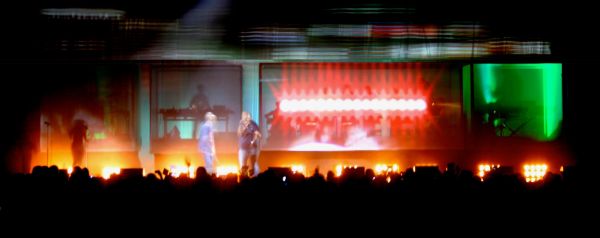 Kanye didn’t see the actual show. What happened was that a very good friend of mine called Richard Brown was working with him on some films and heard he heard Kanye sounding off over the phone to his designer. And Richard said, “Well, if you need a new set designer, have a look at this,” showed him my website and before I knew it, I was on a plane to New York. Luckily Kanye had only made two albums at that point so I printed out all the lyrics and learnt them on the plane. I also had to take a huge suitcase of books about fine art, exhibition catalogues and so on, to use as reference points – these days you’d just open your laptop and Google them but Google wasn’t so effective then. It’s extraordinary how things have changed.
Kanye didn’t see the actual show. What happened was that a very good friend of mine called Richard Brown was working with him on some films and heard he heard Kanye sounding off over the phone to his designer. And Richard said, “Well, if you need a new set designer, have a look at this,” showed him my website and before I knew it, I was on a plane to New York. Luckily Kanye had only made two albums at that point so I printed out all the lyrics and learnt them on the plane. I also had to take a huge suitcase of books about fine art, exhibition catalogues and so on, to use as reference points – these days you’d just open your laptop and Google them but Google wasn’t so effective then. It’s extraordinary how things have changed.
MTV had just made a huge profile about Kanye and when I got to his studio, all his people were sitting around watching it, which was quite useful. And then we launched into the meeting. We only had 10 days until the show opened so it was fairly pressurized but I knew he was basically after a version of the Wire set.
From Trevor Nunn to Kanye West – quite a contrast.
Yes, but you know, Kanye’s education is not so dissimilar from mine or a member of Wire’s. There is a common denominator amongst all the people I work with, whether it’s Alison Goldfrapp or Kanye or Gaga:all these people are the sort who would have gone to see Pina Bausch of a weekend – otherwise they wouldn’t be interested in the work I do. And Kanye is pretty erudite – he dropped out of university to record his first album and his blog is a beacon for people who are interested in fine art and architecture. Everything he sees that he likes, he very generously puts on on his blog so that his fans can be enriched by it. He calls it Kanye University.
Since then you’ve designed big stadium shows for Mika, Pet Shop Boys, Take That and Lady Gaga. How did that come about?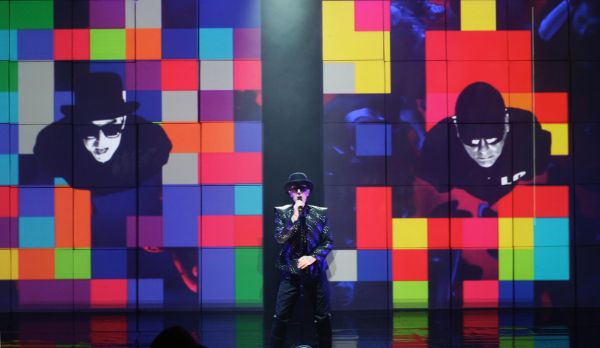 I first met Gaga through Pet Shop Boys (pictured right). I worked with them on their musical, Closer to Heaven (2005), and although it wasn’t their biggest triumph, it ran for a year. I didn’t hear from them for ages and then, after I’d finished working with Kanye, I had a phone call from Pet Shop asking me to do their 2006 Fundamental tour – I presumed it was because of the work I’d been doing with Kanye but they didn’t know anything about it. So I worked on that tour and then they asked me to design their set for the 2009 Brit Awards – they were due to receive a life-time achievement award. Anyway, they said they had this person called Lady Gaga coming on to sing the Dusty Springfield bit, [Dusty Springfield had made a guest appearance of the Pet Shop Boys’ 1987 hit, What Have I Done to Deserve This?] and everyone was like, “Who’s she?” She really wasn’t very well-known at all then - I Googled her and there were just clips of her wandering in and out of clubs in a hoodie. But Neil Tennant said, “Trust me, she’s going to be huge.” And Neil is always right about these things. So I met her very briefly on that and worked with her on her performance.
I first met Gaga through Pet Shop Boys (pictured right). I worked with them on their musical, Closer to Heaven (2005), and although it wasn’t their biggest triumph, it ran for a year. I didn’t hear from them for ages and then, after I’d finished working with Kanye, I had a phone call from Pet Shop asking me to do their 2006 Fundamental tour – I presumed it was because of the work I’d been doing with Kanye but they didn’t know anything about it. So I worked on that tour and then they asked me to design their set for the 2009 Brit Awards – they were due to receive a life-time achievement award. Anyway, they said they had this person called Lady Gaga coming on to sing the Dusty Springfield bit, [Dusty Springfield had made a guest appearance of the Pet Shop Boys’ 1987 hit, What Have I Done to Deserve This?] and everyone was like, “Who’s she?” She really wasn’t very well-known at all then - I Googled her and there were just clips of her wandering in and out of clubs in a hoodie. But Neil Tennant said, “Trust me, she’s going to be huge.” And Neil is always right about these things. So I met her very briefly on that and worked with her on her performance.
How did that go down?
Oh, she’s great. Really hard-working, really professional. She always turned up on time with all the right gear. Then she and Kanye decided to do a joint tour and we put a lot of work into putting that together. At the beginning of the process, Gaga still wasn’t such a huge name but she was never going to be the support act, it was meant to be a joint show. However, her star was rapidly rising and rising and, for various reasons, Gaga pulled out of the tour and asked me to design her solo show – which turned out to be the Monster Ball Tour. But I was instantly on my high horse and said, absolutely not,out of respect for Kanye. But Gaga is very determined and she was immediately on the phone to Kanye who rang me and said, “Please, just go ahead and do it. This is her time. You have my blessing. Make it good.”
So that’s how I ended up working with Gaga. She has her own creative department, the Haus of Gaga and I was really there to help them realise their vision.
Which was?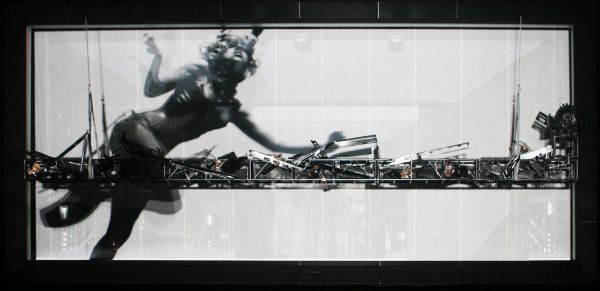 It was multifarious (pictured left). They had a very bold concept which was to put the show in a big white box. Pop shows are usually black and trussed with scaffolding – they just look like a lot of lighting kit. Gaga just wanted this pure white set with no lighting equipment visible. I think that’s what attracted her to my work because when you look at pictures of it, you can’t see any lights and that immediately makes it look different to other pop shows.
It was multifarious (pictured left). They had a very bold concept which was to put the show in a big white box. Pop shows are usually black and trussed with scaffolding – they just look like a lot of lighting kit. Gaga just wanted this pure white set with no lighting equipment visible. I think that’s what attracted her to my work because when you look at pictures of it, you can’t see any lights and that immediately makes it look different to other pop shows.
Do you approach every project in the same way?
Absolutely. I immerse myself in the material to hand - be it the lyrics or the script or the libretto - and do lots of intensive research and then I make my models. I always make a model. I worked on a show for Muse recently and the production manager said, "Es, if you find it therapeutic, go ahead and make a model. But we don't really need it." And then of course, we were in a meeting with the band and they loved playing with it - every one does. I simply can't work without them.
I love all the work I’ve done for theatres and opera houses but I have to admit, one of the things I like about the shift in my career is that so many people get to see my work. Now I’ve got over worrying whether or not I can be an opera designer and also design for Take That, I do enjoy that fact that 80,000 people saw the Take That Circus tour, every night for 21 nights. And whether or not you’re a Take That fan, it’s really, really uplifting, sitting in Wembley Stadium with 80,000 people singing along word-perfect to all the songs.You don’t get that at the Bush!
Having said that, one problem with the pop shows is the very few musical artists like to rehearse. They want it to look brilliant, but apart from Take That and Pet Shop, they don’t understand that you need to rehearse the cues and really tech it. But Gaga works very hard and I think she’ll make fantastic shows as she goes on – and remember, she’s only 23 - because she’s got such vision. She does this wonderful thing where you show her a design and she says, [cue Lady Gaga impression] “Oh, that’s great. Can you just puke on it?” And what she means is, “You’ve designed it and now I want you to make it look as if it just happened. I need you to bring some energy, some anarchy - bring it alive.”
Have you ever come unstuck? Have you ever felt that you simply didn’t have an idea for a project?
That happened a lot when I first started. I would just dry up. There was a period when I was working in the theatre, doing quite a few projects at a time and I would think “this just isn’t going right,” and actually I wasn’t completely happy with some of the theatre projects I did in 2005. I think what used to happen is that if a director really wanted something and I wasn’t completely convinced it would work,I would still go along with it. I now know that I have to own every idea on that stage – I have to be able to put my hand on my heart and say, “That’s mine.” But I think that kind of confidence comes with age and experience.
So how does it feel to be back working in the Arcola – a space you know well?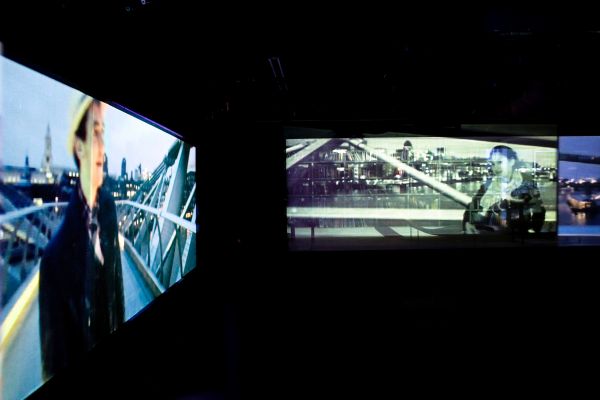 It’s great. (Adam Best as Vincent and Sian Clifford as Rachel in Pieces of Vincent, pictured right) And actually, this experience will be completely different because on the strength of all the work I've done on pop shows, we've been lent 11 projectors and five playback systems plus all the technical support we need. I mean, that's tens of thousands of pounds worth of sponsorship. But I don't want people to come expecting a multi-media extravaganza. We've basically taken the form of the play and expressed it in the design. It's certainly not multi-media for its own sake. It's got a great cast and ultimately - as is always the case - the writing is at the heart of it.
It’s great. (Adam Best as Vincent and Sian Clifford as Rachel in Pieces of Vincent, pictured right) And actually, this experience will be completely different because on the strength of all the work I've done on pop shows, we've been lent 11 projectors and five playback systems plus all the technical support we need. I mean, that's tens of thousands of pounds worth of sponsorship. But I don't want people to come expecting a multi-media extravaganza. We've basically taken the form of the play and expressed it in the design. It's certainly not multi-media for its own sake. It's got a great cast and ultimately - as is always the case - the writing is at the heart of it.
- Pieces of Vincent is at the Arcola Theatre until 25 September
- Find David Watson on Amazon
- Es Devlin's website
- What's on at the Arcola Theatre this season

Add comment